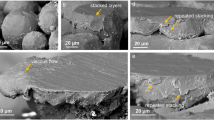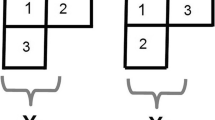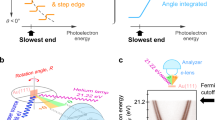Abstract
IN consequence of the recent communication of R. C. French 1 on the structure of polished surfaces—investigated by high-speed electrons—and the fact that at the same time W. Boas and E. Schmid,2 using Laue reflection diagrams, come to rather different conclusions, it seems desirable to mention some of the results, obtained on different experimental lines and published in Holland about a year ago.3 These latter results suggest that polishing should be considered primarily as a very fine process of abrasion of the suitably prepared surface, accompanied by a levelling of surface lamellæ (or micellæ), the first step in this direction already being made when grinding the specimen (plastic deformation in the surface layers).
This is a preview of subscription content, access via your institution
Access options
Subscribe to this journal
Receive 51 print issues and online access
$199.00 per year
only $3.90 per issue
Buy this article
- Purchase on Springer Link
- Instant access to full article PDF
Prices may be subject to local taxes which are calculated during checkout
Similar content being viewed by others
References
NATURE, 129, 169; 1932.
Naturwiss, 20, 416; 1932.
L. Hamburger, De Ingenieur, 46, W, 91–98;1931.
L. Hamburger, Paper read before the Colloid Section of the Netherl. Chem. Ver. at the meeting of May 28, 1932; in print.
See R. Zsigmondy, "Zur Erkenntnis der Kolloide.", p. 87; 1905.
L. Hamburger, Proc. Kon. Ak. v. Wet. Amsterdam, 21, 1066; 1918. T. Haigh, Report Brit. Sci. Instr. Res. Ass. 1921: J. W. French, NATURE, 110, 97; 1922.
Z. phys. Chem., 132, 295; 1928.
Proc. Kon. Ak. v. Wet. Amsterdam, 1916, 1917.
See also Rec. d. Trav. chim. des Pays-Bas (4), 12, 351, 441, 475; 1931.
In case of more severe forms of cold-working, complications occur. See W. G. Burgers, Z. Phys., 58, 11; 1929.
Spring, 1903; E. Cohen, 1910.
See L. Hamburger, Ann. d. Phys. (5), 10, 789, 905; 1931: 11, 40; 1931.
Author information
Authors and Affiliations
Rights and permissions
About this article
Cite this article
HAMBURGER, L. Structure of Polished Solids. Nature 130, 435–436 (1932). https://doi.org/10.1038/130435b0
Issue Date:
DOI: https://doi.org/10.1038/130435b0
This article is cited by
-
Friction of Metals: A Review of Microstructural Evolution and Nanoscale Phenomena in Shearing Contacts
Tribology Letters (2021)
-
Surface Temperature of Rubbing Solids and the Formation of the Beilby Layer
Nature (1937)
-
Limiting Mobilities of Some Monovalent Ions and the Dissociation Constant of Acetic Acid at 25°
Nature (1932)
Comments
By submitting a comment you agree to abide by our Terms and Community Guidelines. If you find something abusive or that does not comply with our terms or guidelines please flag it as inappropriate.



